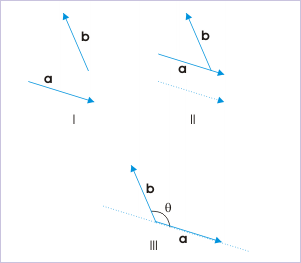The Fundamentals
Up until now, we have assumed that any force acting on an object has been parallel to the direction of motion. We have considered our motion to be one dimensional, only acting along the x or y axis. To best examine and understand how nature operators in our three-dimensional world, we will first discuss work in two dimensions in order to build our intuition.
A force does not have to, and rarely does, act on an object parallel to the direction of motion. In the past, we derived that W = F d; such that the work done on an object is the force acting on the object multiplied by the displacement. But this is not the whole story. This expression contains an assumed cosine term, which we do not consider for forces parallel to the direction of motion. "Why would we do such a thing? " you may ask. We do this because the two are equivalent. If the angle of the force along the direction of motion is zero, such that the force is parallel to the direction of motion, then the cosine term equals one and does not change the expression. As we increase the force's angle with respect to the direction of motion, less and less work is done along the direction that we are considering; and more and more work is being done in another, perpendicular, direction of motion. This process continues until we are perpendicular to our original direction of motion, such that the angle is 90, and the cosine term would equal zero; resulting in zero work being done along our original direction . Instead, we are doing work in another direction!

Angle
Recall that both the force and direction of motion are vectors. When the angle is 90 degrees, the cosine term goes to zero. When along the same direction, they equal one.
Let's show this explicitly and then look at this phenomena in terms of a box moving along the x and y directions.
We have discussed that work is the integral of the force and the dot product respect to x. But in fact, dot product of force and a very small distance is equal to the two terms times cosine of the angle between the two. F * dx = Fdcos(theta). Explicitly,
A Box Being Pushed
Consider a coordinate system such that we have x as the abscissa and y as the ordinate. More so, consider a box being pushed along the x direction. What happens in the following three scenarios?
- The box is being pushed parallel to the x direction?
- The box is being pushed at an angle of 45 degrees to the x direction?
- The box is being pushed at an angle of 60 degrees to the x direction?
- The box is being pushed at an angle of 90 degrees to the x direction?
In the first scenario, we know that all of the force is acting on the box along the x-direction, which means that work will only be done along the x-direction. More so, a vertical perspective the box is not moving - it is unchanged in the y direction. Since the force is acting parallel to the direction of motion, the angle is equal to zero and our total work is simply the force times the displacement in the x-direction.
In the second scenario, the box is being pushed at an angle of 45 degrees to the x-direction; and thus also a 45 degree angle to the y-direction. When evaluated, the cosine of 45 degrees is equal to
In the third scenario, we know that the force is acting at a 60 degree angle to the x-direction; and thus also a 30 degree angle to the y-direction. When evaluated, cosine of 60 degrees is equal to 1/2. This means that the force is equally acting in the x and y-direction! The work done is linear with respect to both x and y.
In the last scenario, the box is being pushed at an angle perpendicular to the x direction. In other words, we are pushing the box in the y-direction! Thus, the box's position will be unchanged and experience no displacement along the x-axis. The work done in the x direction will be zero.